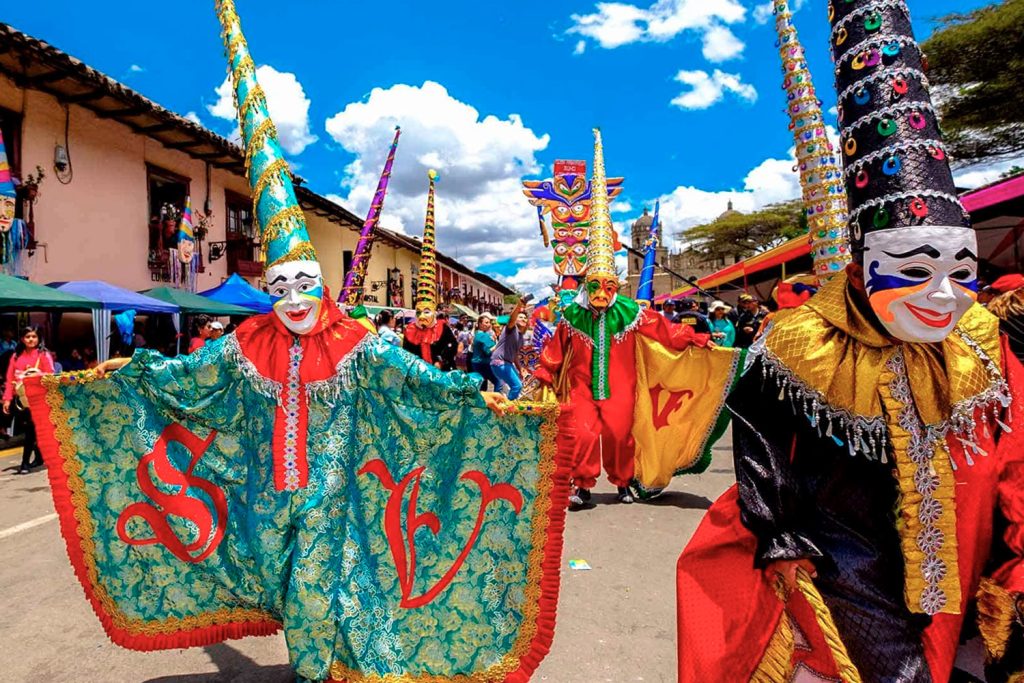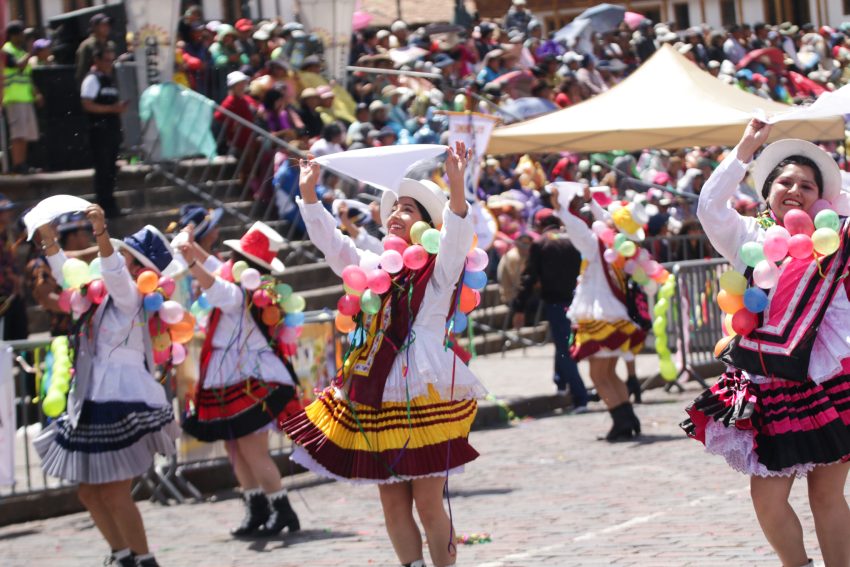The Carnival of Cusco is one of Peru’s most vibrant and colorful festivities, where pre-Hispanic Andean roots blend with European influences, creating a unique cultural syncretism. This celebration honors Pachamama (Mother Earth) with ancestral rituals and overflows with music, dances, games, and traditional cuisine. If you plan to visit Cusco during this time, prepare for an experience that magically and festively connects the past and present.
Essential Elements of the Cusco Carnival:
The Cusco Carnival festival combines Andean and European traditions, offering a unique cultural experience. Among its most notable elements are:
Andean Rituals: Honoring Pachamama
One of the most profound aspects of the Cusco Carnival is its deep connection to Andean spirituality. Before the festivities, communities perform rituals to pay homage to Pachamama (Mother Earth) and the Apus (sacred mountains). These rituals, which include offerings of coca leaves, chicha, and flowers, express gratitude for the harvests and request prosperity for the coming year. In some communities, people also conduct livestock fertility ceremonies, strengthening the bond between the carnival and agriculture.
Compadres and Comadres Thursday: The Celebration of Unity
The Compadres and Comadres Festival is one of the most anticipated celebrations of the Cusco Carnival. Its origin dates back to the colonial era when the Spanish introduced the compadrazgo as a spiritual bond through baptism or marriage. Over time, this custom intertwined with the Andean worldview, symbolizing respect for Pachamama and the Apus.
Key Dates in 2025:
- Compadres Thursday: February 20
- Comadres Thursday: February 27
Traditions and Activities:
Rag Dolls: Satirical representations of public figures or popular characters hung on poles and balconies.
Gastronomy: Puchero, a stew of meat and vegetables, is the star dish, accompanied by drinks like chicha de jora and frutillada.
Comparsas and Music: Bands perform huayno and Cusco carnival songs, while the Huaylaca, a woman-dressed character, enlivens the party with humor and wit.
Doll Contest: Organized by the Municipal Company of Festivities and Tourism Promotion of Cusco (EMUFEC), it awards creativity and the use of recycled materials.


Local markets: The heart of the celebration
The Cusco markets are key settings during the Carnival. In places like the San Pedro Market, Ccascaparo Market, El Molino Market, and Vinocanchón Market, merchants decorate their stalls with streamers and balloons, organize costume contests, and share food and drink with customers and colleagues. Additionally, communities perform symbolic “baptisms” of new compadres and comadres, strengthening their social bonds.
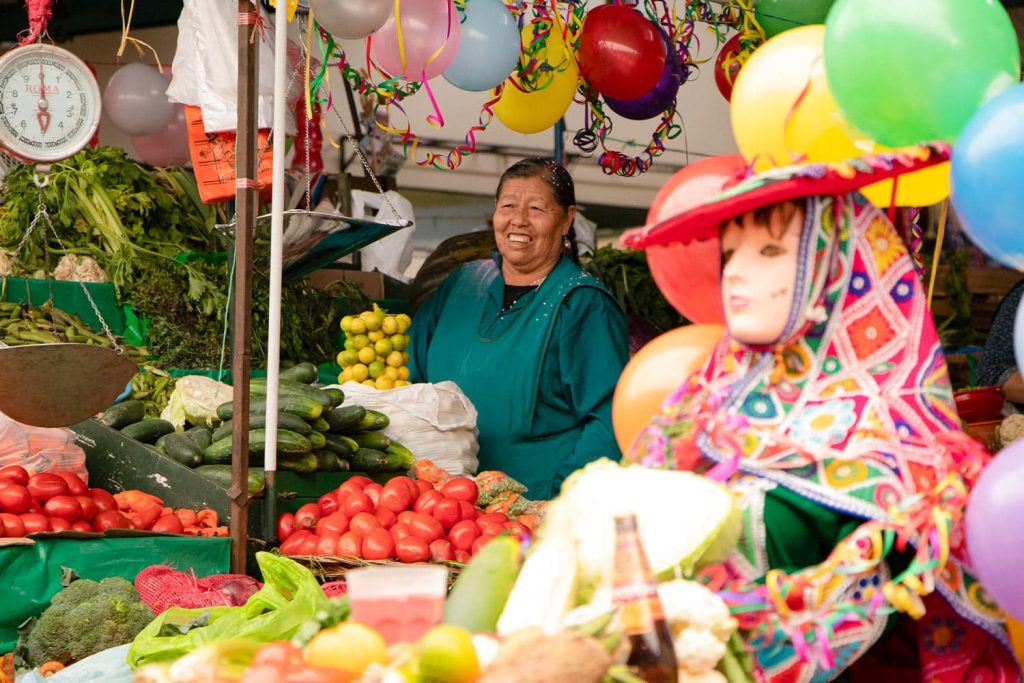
Pasacalles: The parade of joy
Kacharpari 2025 – March 9
The Kacharpari 2025 is a pasacalle that marks the closing of the Cusco Carnival with a display of music, dances, and tradition in an atmosphere of joy and culture. During this festivity, thousands gather to enjoy parades of comparsas, folk dances, water games, talcum powder, streamers, and exquisite traditional gastronomy that includes puchero, chicha de jora, and frutillada. This event not only represents the farewell of the carnival but also strengthens the cultural identity of the Cusco people, becoming an unforgettable experience for locals and tourists. If you visit Cusco in March, do not miss the Kacharpari 2025, where tradition and celebration come together to bid farewell to the carnival with great enthusiasm and color.
Qhaswa Raymi 2025 – March 23
Qhaswa Raymi is the Quechua name for the traditional Carnival Festival in Cusco, where “Qhaswa” means Carnival and “Raymi” means Festival. Each year, the Regional Government of Cusco organizes a spectacular multicolored pasacalle, where music, dance, and the region’s cultural richness come together in a vibrant celebration.
This carnival parade in Cusco brings together delegations from the region’s 13 provinces and 116 districts, along with various local entities. The parade travels through the city’s main streets, passing emblematic avenues and squares like Túpac Amaru Square, culminating in the majestic Plaza de Armas.
The festivity bursts with vibrant colors, showcases traditional costumes, and features folk dances and chants celebrating Andean identity. Additionally, Cusco gastronomy plays an important role, with traditional dishes that delight attendees. As is tradition in the Cusco Carnivals, the game with water balloons, foam, and flour is part of the fun, creating a festive and joyful atmosphere.
Experiencing the Qhaswa Raymi in Cusco is a unique experience. Tradition and modernity merge in one of the most anticipated festivities of the year.
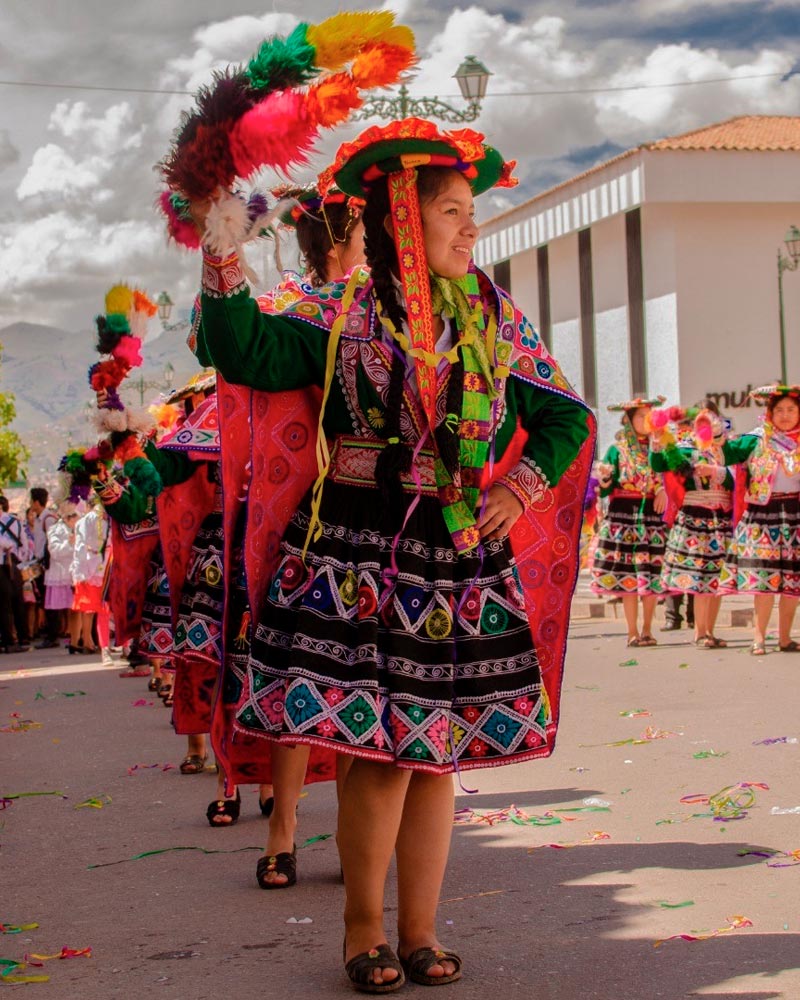
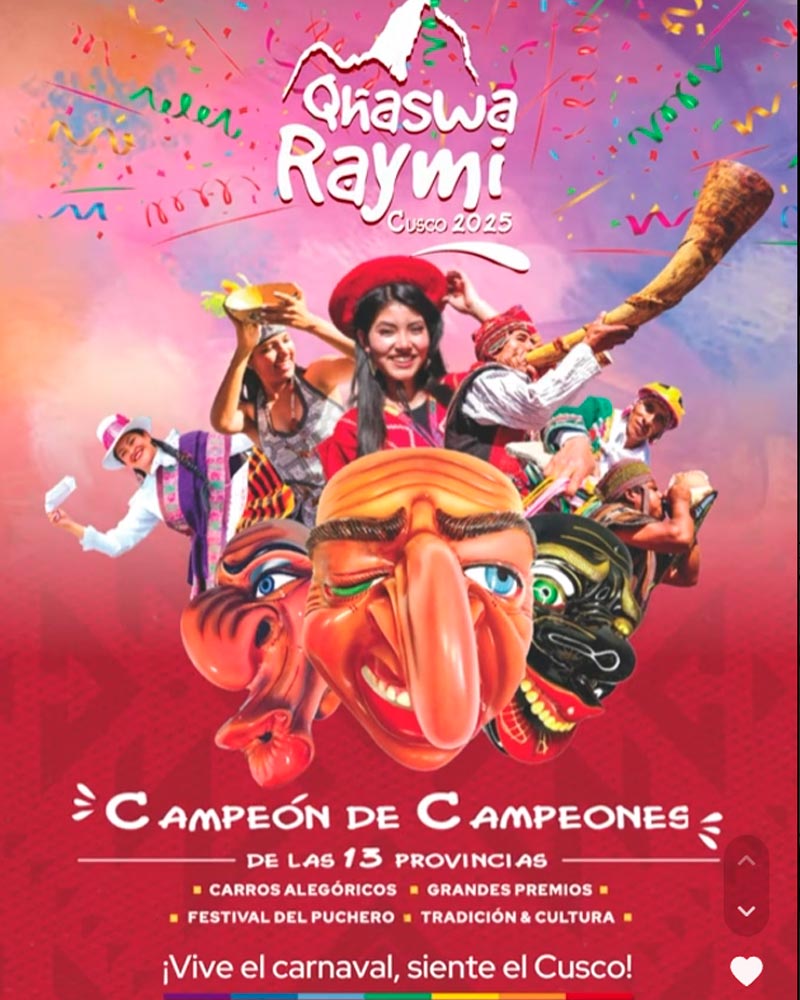
Carnival Gastronomy: Flavors that Unite
Puchero
Puchero, also known as t’impu, is the emblematic dish of the festivity. It is a stew made with beef lamb, accompanied by potatoes, cabbage, chickpeas, rice, sweet potatoes, and peaches. Its preparation symbolizes abundance and the union between family and friends, as it is served in large portions to share. This dish has both Andean and Spanish roots. During pre-Hispanic times, the Incas prepared broths with meat and tubers, while the conquerors brought the custom of hearty stews. Over time, puchero became an indispensable festive dish in carnivals and other Cusco celebrations.
Chicha
Chicha de jora is an ancestral drink of the Andes made from fermented corn. In the Carnival Festival, chicha plays an essential role. It is used in toasts to honor compadres and comadres and to strengthen bonds of friendship and community.
Frutillada
Frutillada is a fermented drink made from chicha de jora, strawberries (frutillas), sugar, and sometimes a touch of liquor. Its pink color and sweet flavor make it a favorite during Cusco festivities.
Beer
Beer accompanies festive meals, refreshes the dancers, and becomes the protagonist of toasts among compadres and comadres. It is often combined with chicha, creating a mixture known as “chicha con chela,” a widespread practice in Cusco festivities.
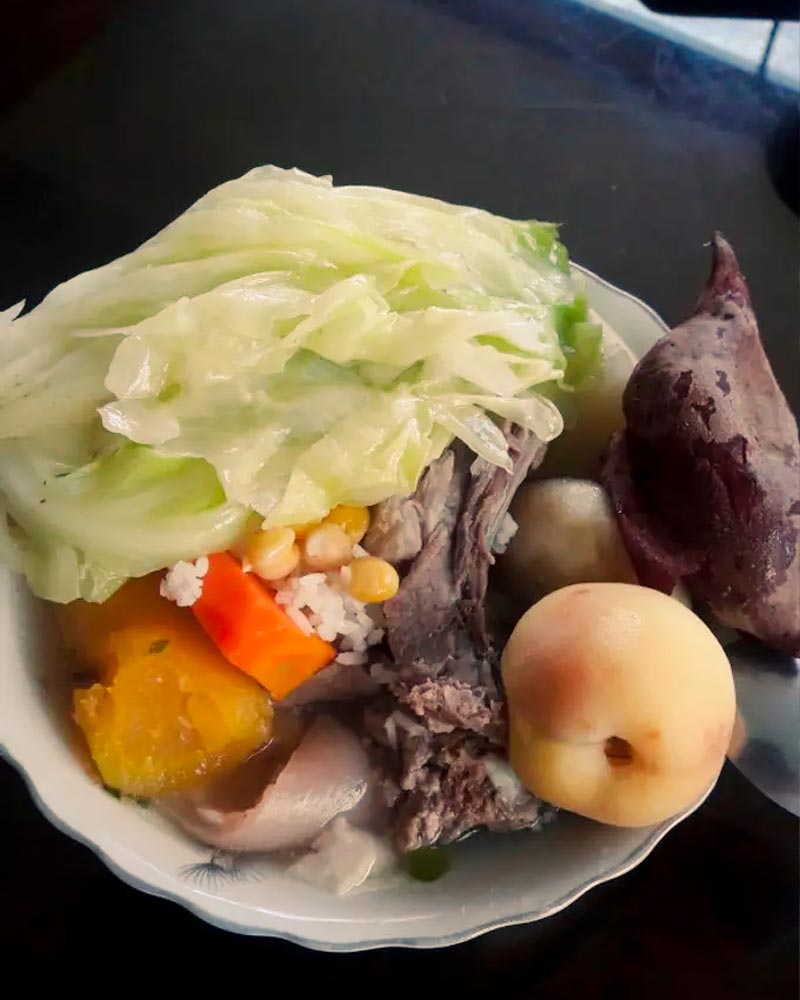

Carnival Games: Fun and Tradition
The Carnival in Cusco is a vibrant celebration in which men and women divide into two teams and play by throwing water, water balloons, flour, and even shoe polish in fun and camaraderie. Over time, this festivity has evolved, adapting its games and traditions to new customs and safety measures.
Initially, participants used perfumed water, eggs filled with aromatic liquids, and diethyl ether. The latter generated a refreshing sensation but was highly flammable and toxic, leading to its prohibition. These practices were part of social interaction, especially among young people, as a form of integration and courtship.
Over time, the Cusco carnival abandoned dangerous elements and adopted safer alternatives. In the 20th century, eggs and perfumes were replaced by water balloons, water guns, and flour, allowing the festivity to remain fun without causing excessive discomfort. Today, participants use aerosol foam during the games, an element that has transformed interactions during the festivities and gained popularity through commercialization. This shift has solidified the carnival as one of Cusco’s most significant celebrations.
Despite these changes, some traditions have endured. In highland regions like Ayacucho, people still use talcum powder to play, while flour plays a central role in Cusco’s celebrations. Introducing products like streamers, talcum powder, and foam sprays has modernized the festivity without losing its festive essence, ensuring that the Andean Carnival continues to be a vibrant expression of culture and joy.
Plaza de Armas: Fun and Tradition
The Plaza de Armas of Cusco is the epicenter of the Cusco Carnival celebration, bringing together locals and visitors in an atmosphere of joy and tradition. Both on Carnival Sunday and during the Carnival Farewell, the plaza becomes a stage of overflowing festivity, where men and women participate in an animated water game.
Attendants enjoy throwing water balloons at friends and strangers, while aerosol foam and colored flour add a festive touch. Laughter and excitement blend with the sound of splashing water, creating a unique experience that captures the essence of the Cusco carnival.
The squares of the historic center are icons of carnival fun, thanks to their open spaces and water fountains, which many use to replenish and continue the game. This celebration is an opportunity to enjoy and experience one of Cusco’s most vibrant and authentic traditions.

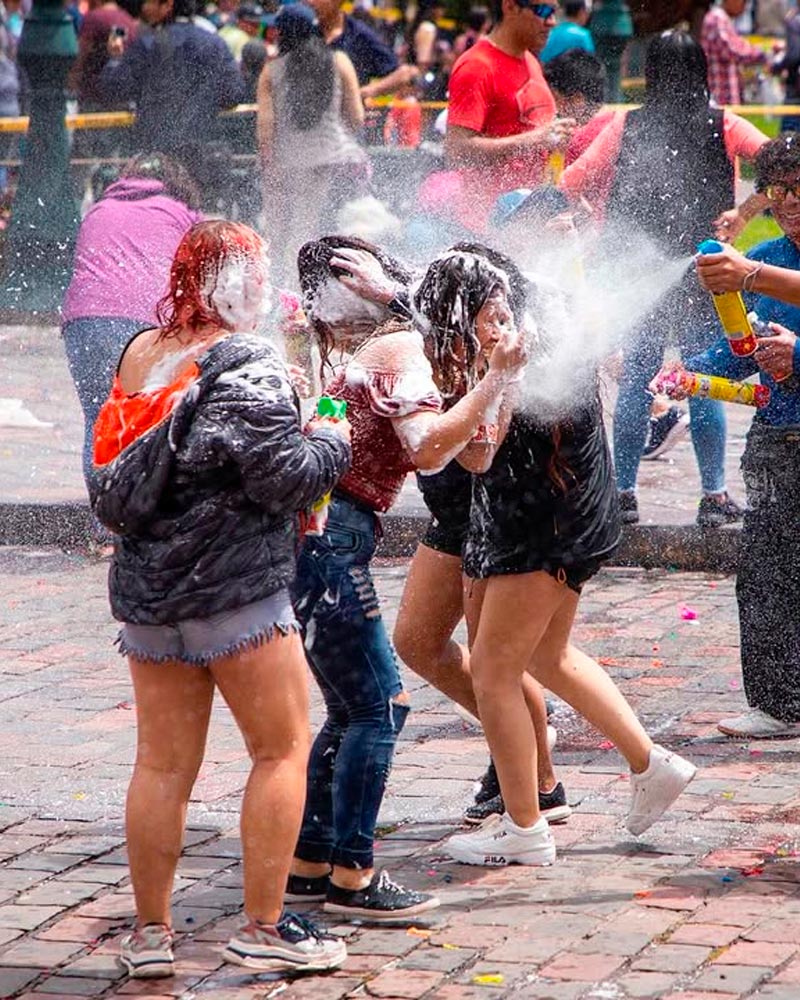
Yunza or Cortamonte
The yunza, also known as cortamonte, is one of the most vibrant traditions of the Cusco Carnival. With Andean and European roots, this festivity symbolizes abundance, fertility, and community union.
People decorate a tree with gifts, streamers, and balloons and set it up in squares or patios. Around it, attendees dance to the rhythm of huaynos and carnival songs until the most awaited moment: cutting the tree with an axe or machete. The one who delivers the final blow and falls the tree becomes the godfather or godmother of the next yunza.
In Cusco, the yunza stands as a key event in the carnivals. Neighborhoods, squares, and rural communities celebrate it with the same format: live music, dance, and large gatherings. Participants decorate a tree, usually a eucalyptus, with toys, utensils, and surprises, which they collect when it falls. Alongside the dance and the excitement of the cortamonte, the party features dishes like puchero and traditional drinks such as chicha de jora, frutillada, and beer. It is an event where compadres, comadres, friends, and families strengthen bonds and celebrate life. The gifts on the tree represent generosity and prosperity. The friendly competition to cut it ensures the continuity of the tradition, as the one who feels it assumes the organization of the next celebration.
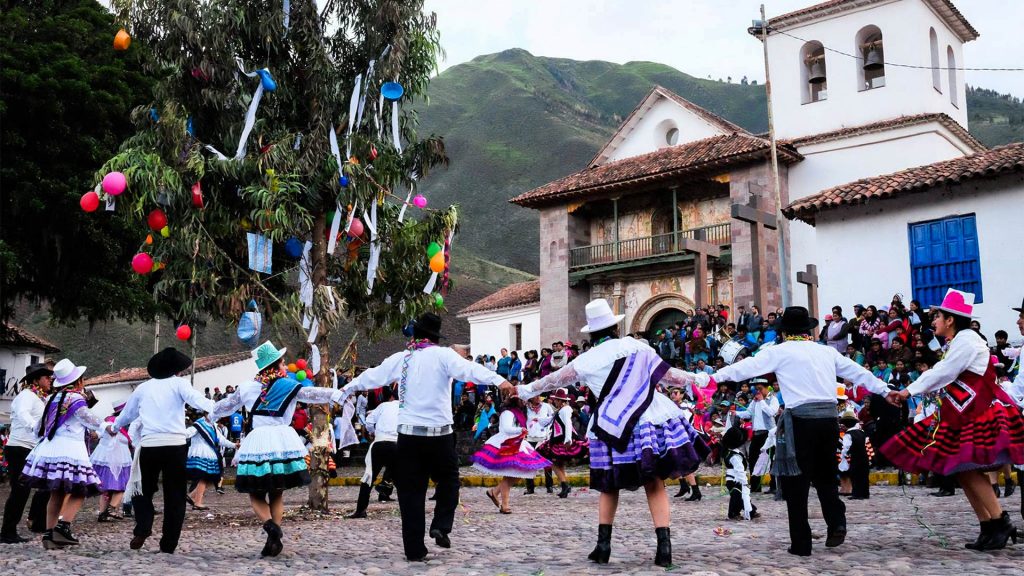
Carnivals in Peru: Other Unmissable Celebrations
Carnivals in Apurímac: To the Rhythm of Pukllay and T’ikapallana
Carnival of Andahuaylas: The Great Pukllay 2025
The Carnival of Andahuaylas, known as Pukllay (Quechua: “game” or “play”), is one of the most important festivities in Peru. 2025, it will be celebrated from March 19 to 21, bringing together more than 200 national and international delegations for a tremendous cultural encounter.
This carnival is distinguished by its colorful comparsas, exhibitions of traditional dances and music, and contests that award the best exponents of urban and original carnival, highlighting the cultural richness of rural communities.
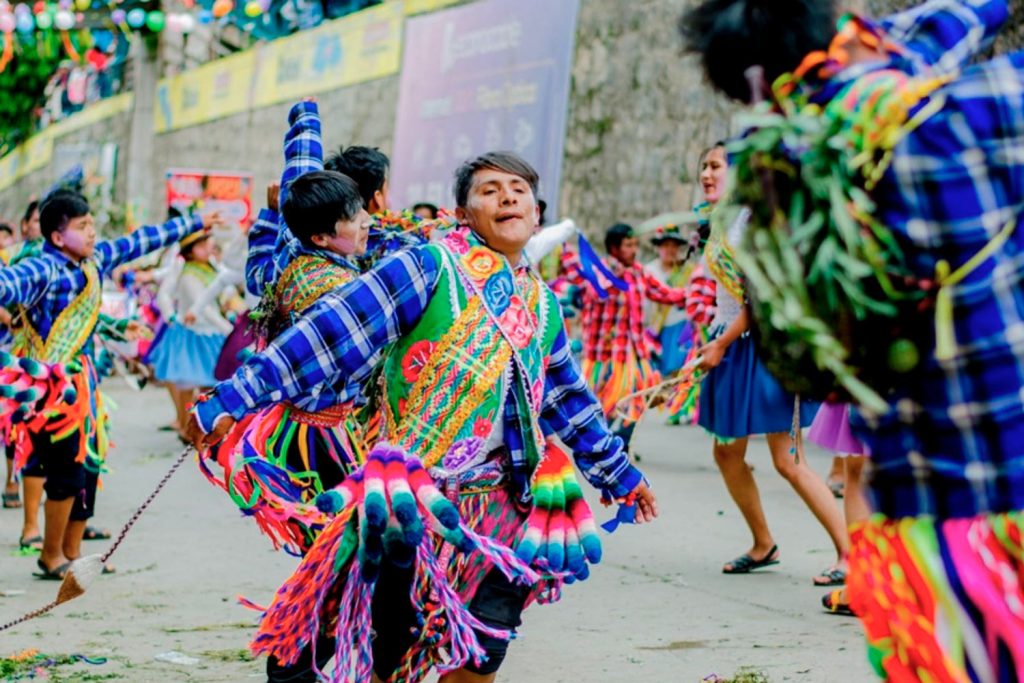
Carnival of Cotabambas: The Magic of T’ikapallana
In Cotabambas, specifically in Tambobamba, the carnival is celebrated to the rhythm of T’ikapallana, a dance whose name means “flower gathering.” During the festivity, participants pilgrimage to a nearby pampa to gather flowers, considered symbols of fertility and prosperity. These are then used to adorn crosses, animals, and attire.
In addition to the dance, T’ikapallana is linked to games and youthful courtships, reflecting the playful essence of the carnival and the continuity of Andean traditions.
Carnivals in Ayacucho: The Most Joyful Comparsas in Peru
The Carnival of Ayacucho, with its epicenter in Huamanga, is one of the most vibrant celebrations in Peru. It stands out for its pasacalles, comparsas, and the traditional Seqollonakuy, a ritual confrontation with whips between two people.
During the festivity, quenas, tinyas (a type of drum), and charangos (small, resonant guitars) fill the Plaza Mayor, accompanying the dances and comparsas. The celebration also includes games with water, talcum powder, and streamers, creating an unparalleled festive atmosphere. Puchero is the emblematic dish of the carnival, combining dried meat, bacon, potatoes, corn, chuño, and fruits, offering a feast of traditional flavors. What sets the Huamanga Carnival apart is its strong focus on music and comparsas, consolidating it as an unmissable cultural event that attracts tourists and locals to experience the essence of Ayacucho at its finest.
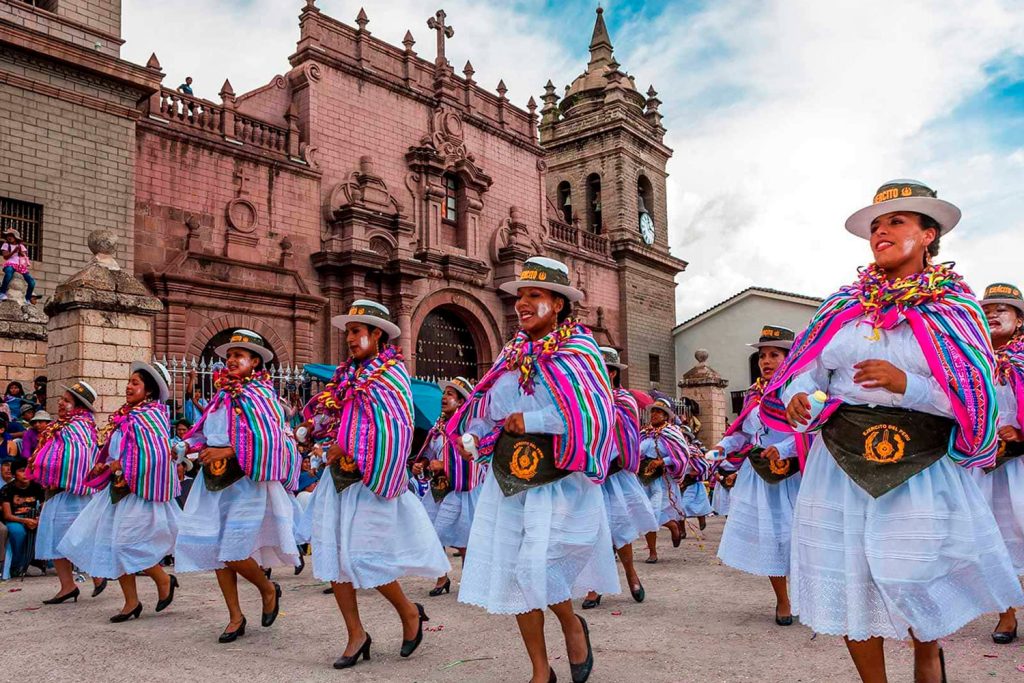
Carnivals in Cajamarca: Capital of the Peruvian Carnival
Cajamarca, known as the “Capital of the Peruvian Carnival,” celebrates this festivity with parades of comparsas, allegorical floats, and the arrival of Ño Carnavalón, a satirical character who embodies the festive spirit. Music and coplas, improvised verses with satirical, romantic, or festive tones, are the soul of the carnival, accompanied by games with water, talcum powder, and paint. Gastronomy also plays a leading role, highlighting the Frito Cajamarquino, a traditional dish that complements the joy and tradition of this colorful festivity.
